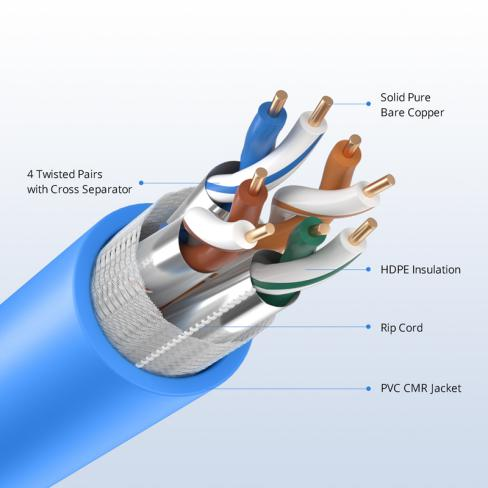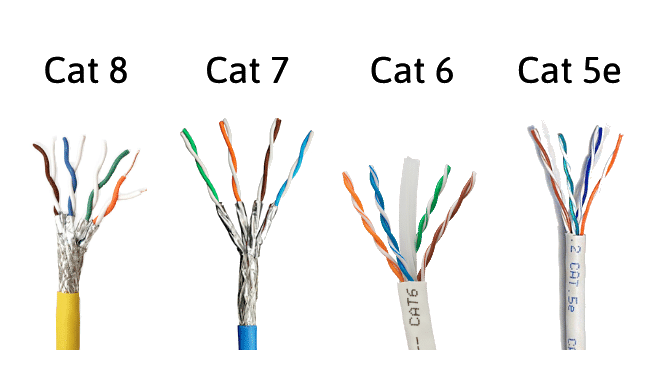In today’s fast-paced digital world, a reliable internet connection is non-negotiable. Whether you’re streaming 8K videos, managing a data center, or dominating online gaming, your Ethernet cable can make or break your experience. Enter the Cat 8 Ethernet cable—the latest and most advanced standard in networking cables. But what exactly is Cat 8, and why should you care? In this ultimate guide, we’ll dive into its specifications, benefits, and real-world applications, helping you decide if it’s the right choice for your needs.
What is Cat 8 Ethernet Cable?
Ethernet cables are the backbone of wired networks, connecting devices like computers, routers, and switches. The “Cat” in Cat 8 stands for “Category,” and each category represents a leap in performance. Cat 8 is the pinnacle of this evolution, designed for ultra-high-speed data transfer and future-proof networking.
Technical Specifications
- Bandwidth: Up to 2000 MHz—think of it as a superhighway with more lanes for data traffic.
- Speed: Supports 25 Gbps or 40 Gbps over short distances (up to 30 meters).
- Shielding: Features S/FTP (Shielded Foiled Twisted Pair) construction, with each pair shielded and an overall shield to minimize interference.
- Length Limit: Optimal performance up to 30 meters; beyond that, signal degradation may occur.
Features and Benefits
Cat 8 isn’t just about raw speed—it’s built for reliability. Its advanced shielding reduces crosstalk and electromagnetic interference (EMI), ensuring stable connections even in busy environments. Plus, it’s backward compatible with older standards like Cat 5e and Cat 6, making it a versatile upgrade option. Whether you’re future-proofing your home network or powering a cutting-edge enterprise, Cat 8 delivers.
Comparisons with Other Categories
Wondering how Cat 8 stacks up against its predecessors? Here’s a breakdown:
| Category | Bandwidth | Max Speed | Shielding | Best For |
| Cat 5e | 100 MHz | 1 Gbps | UTP (Unshielded) | Basic home use |
| Cat 6 | 250 MHz | 10 Gbps | UTP or STP | Streaming, small offices |
| Cat 7 | 600 MHz | 10 Gbps | S/FTP | High-speed networks |
| Cat 8 | 2000 MHz | 25/40 Gbps | S/FTP | Data centers, gaming, 8K |
Cat 8 vs Cat 7
Cat 7 offers solid performance with 600 MHz bandwidth and 10 Gbps speeds, but Cat 8 quadruples the bandwidth and doubles (or quadruples) the speed. Its superior shielding also makes it better suited for environments with heavy EMI, like industrial settings.
Cat 8 vs Cat 6
Cat 6 is a popular choice for homes and small offices, supporting 10 Gbps up to 55 meters. However, Cat 8’s 2000 MHz bandwidth and 40 Gbps capability make it a giant leap forward, ideal for demanding applications.
Cat 8 vs Cat 5e
Cat 5e is the budget-friendly baseline, handling 1 Gbps for basic needs. Cat 8, by contrast, is a high-performance beast, designed for the data-heavy future—think of it as upgrading from a bicycle to a sports car.
Use Cases for Cat 8 Ethernet Cables
Cat 8 isn’t just a tech flex—it’s a practical solution for specific needs. Here are some scenarios where it shines:
- Data Centers: With 40 Gbps speeds, Cat 8 supports massive data transfers between servers, keeping operations smooth.
- Enterprise Networks: Research labs or businesses with high-speed demands rely on Cat 8 for seamless connectivity.
- Gaming and Streaming: A gamer upgraded to Cat 8 and slashed lag by 50%, enjoying uninterrupted 4K streaming and competitive play.
- Smart Homes: As 8K TVs and IoT devices proliferate, Cat 8 ensures your network can handle the load.
For example, imagine a factory automating its machinery with an OT (Operational Technology) network—Cat 8’s interference resistance and speed make it a perfect fit.
How to Choose the Right Cat 8 Ethernet Cable
Not all Cat 8 cables are created equal. Here’s what to look for:
Quality Considerations
- Materials: Opt for cables with high-grade copper conductors and durable PVC or LSZH jackets.
- Construction: Look for robust shielding (S/FTP) to protect against interference.
Certifications and Standards
Ensure the cable complies with ISO/IEC 11801 or TIA-568-C.2 standards. Certifications like RoHS, UL, and CE signal quality and safety.
Compatibility
Cat 8 works with older devices (e.g., Cat 6 routers), but to maximize performance, pair it with Cat 8-compatible hardware like 40G switches.
Cost Considerations
Cat 8 cables come at a premium, but are they worth it? Let’s break it down:
- Price Range:
- Cat 5e: $5–$10 for 10 meters.
- Cat 6: $10–$20 for 10 meters.
- Cat 7: $20 —$40 for 10 meters.
- Cat 8: $30–$60 for 10 meters.
- Value Assessment:
- Home Users: If you’re streaming Netflix in HD, Cat 6 might suffice. But for 8K or multi-device setups, Cat 8 future-proofs your investment.
- Professionals: Data centers or gamers see immediate ROI with Cat 8’s speed and stability.
For many, the upfront cost of Cat 8 pays off in performance and longevity.
Why Choose DLAY Cable for Your Cat 8 Ethernet Cables
When it comes to Cat 8, quality matters—and that’s where DLAY Cable stands out. Based in Dongguan, China, DLAY Cable brings over 20 years of expertise as a leading network cable manufacturer. Specializing in OEM and ODM solutions, they cater to international traders and wiring brands with top-tier products.
Unmatched Quality Control
DLAY Cable ensures every Cat 8 cable passes rigorous FLUKE testing with high margins, meeting standards like ISO9001, RoHS, UL, CE, CCC, and REACH. Their four-layer co-extrusion foaming technology—rare in China—produces cables at 1000 meters per minute, guaranteeing electrical performance.
Customer-Centric Approach
Need a custom Cat 8 solution? DLAY offers flexible MOQ (minimum order quantities) and fast delivery via FedEx, DHL, or UPS. Contact them at Joyce@dlaycable.com or +86 13712270656 to elevate your brand with high-speed cables.
Conclusion
The Cat 8 Ethernet cable is a game-changer for anyone needing blazing-fast, reliable networking. With up to 2000 MHz bandwidth and 40 Gbps speeds, it’s built for data centers, gamers, and future-ready homes alike. While it costs more than Cat 6 or Cat 7, its performance justifies the investment for high-demand users.
Ready to upgrade? Assess your needs—Cat 8 might be overkill for basic browsing but a must for cutting-edge setups. For premium quality, DLAY Cable offers tailored solutions to power your network. Contact them today and take your connectivity to the next level!
FAQ
Is Cat 8 overkill for home use?
For casual browsing or HD streaming, yes—Cat 6 or Cat 7 suffices. But if you’re into 8K video, gaming, or smart home tech, Cat 8 ensures you’re ready for the future.
Does Cat 8 work with older routers?
Yes, it’s backward compatible with Cat 5e, Cat 6, and Cat 7 devices. However, speeds are limited to your hardware’s capability.
What’s the difference between Cat 8 and Cat 7?
Cat 8 offers higher bandwidth (2000 MHz vs 600 MHz) and faster speeds (25/40 Gbps vs 10 Gbps), plus better shielding for interference-heavy environments.
How long can a Cat 8 cable be?
It performs best up to 30 meters. Beyond that, signal quality may drop, so plan your setup accordingly.



